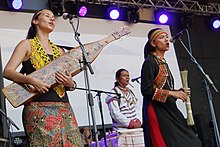Sape (plucked instrument)

Sape , also sapeh, sampet, sampeh, is a boat-shaped fretless lute that is played by several peoples in the interior of the island of Borneo . The traditional, usually four-string plucked instrument usually accompanies dance songs. The sape belongs to a family of boat sounds in Southeast Asia whose names are variants of the Indian word kacapi for a Javanese zither or hasapi for a Batak sound.
Design
Sape are carved from a solid piece of wood. Originally the range was limited, traditional instruments only have two strings and three frets . One string plays the melody, the other (or the other) is struck rhythmically, creating a permanent hum. Its use was limited to ritual dance music for inducing a trance .
Today sape are built with up to five strings and a range of more than three octaves . Even electric sape are common. The instruments are now also used for dance and light music, the melody repertoire is slowly expanding.
Style of play
The ethnic groups living in longhouses along the rivers in the Malaysian state of Sarawak and the Indonesian province of Kalimantan Timur are summarized under the term orang ulu . They belong to the Dayak , Kayan and Kenyah , among others .
The sape's music is complex, with many embellishments and thematic variations. The traditional melodies are inspired by dreams; more than 35 pieces plus variations are known. There are two main types of ritual melodies , one for the longhouses of men and the other for those of women.
The sape is often played as a soloist to accompany the dance or for one's own entertainment, sometimes together with a second instrument that contributes a drone . The Kayan also use two sape and the jatung utang xylophone with ten to eleven sound bars to accompany the dance.
Discography
- Music of Indonesia 13: Kalimantan Strings. Produced by Philip Yampolsky. Smithsonian Folkways, CD 40429, 1997
- Tusau Padan u. a .: Masters of the Sarawakian Sape. Pan Records (Leiden, Netherlands) PAN 2068CD, 1999 (Recordings with Tusau Padan from 1989, who plays a sape with an electric pickup.)
literature
- Patricia Matusky: Sape . In: Grove Music Online , May 28, 2015
Web links
- Sarawak Sapeh. angelfire.com
